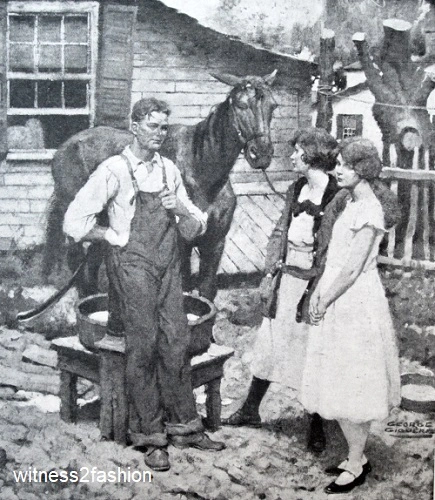
Story illustration by George Giguere, Delineator, February 1924. A young man in bib overalls receives a visit from two pretty girls. Notice the house across the street. This is not necessarily a farm.
When I began writing witness2fashion, I wanted to focus on everyday clothes, clothing for working class people. All the men in my family did manual labor — skilled labor, but impossible to do without getting dirty.
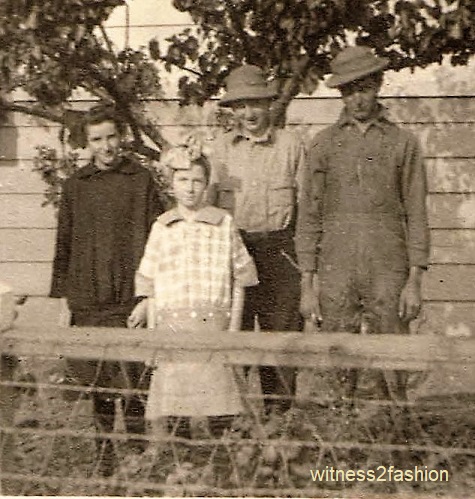
My mother (in light dress) with her older sister and her two brothers. About 1913, judging from their ages. My Uncle Harris, wearing a coverall on the right, would have been working in his family’s ice house by then.
I grew up seeing bib overalls on my father and my uncles. This is not a scholarly history of overalls, but a little tribute to a 20th century classic.
Both overalls [the word I use to refer to bib overalls] and coveralls [by which I mean mean a one piece garment with sleeves which covers the body from neck to ankle] have been around for a very long time. Early Levi jeans were called “waist overalls.”
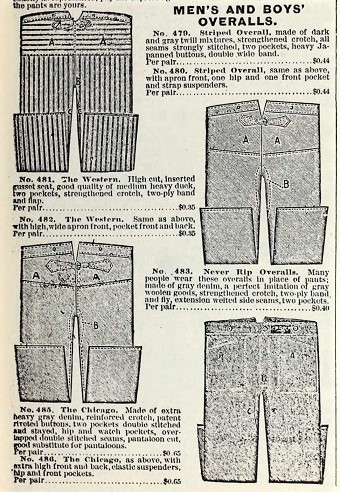
Waist overalls from Sears, Spring 1896. The construction is like that of men’s wool trousers, with a high back and a buckle for adjusting the waist fit. “Overalls” meant a work pant — with or without an “apron” or “bib,” front. The top two were also available in a bib version: “Same as above, with apron front … and strap suspenders.”
For farmers and other men (and sometimes women) doing manual labor, the bib overall was almost synonymous with “work clothes.” It was also an ideal garment for active children.
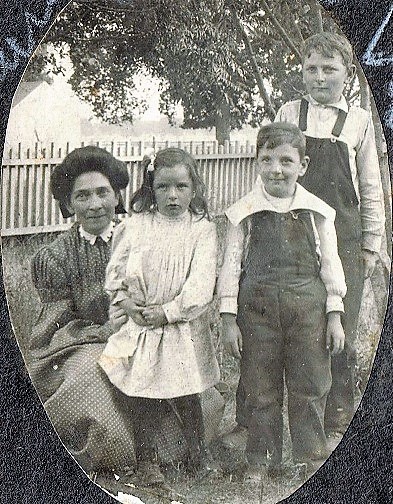
My great-aunt with my Aunt Dorothy, my Uncle Mel, and my Uncle Harris. Dorothy was born in 1901, so this is probably before 1906. My grandmother has very sensibly dressed her boys in bib overalls.
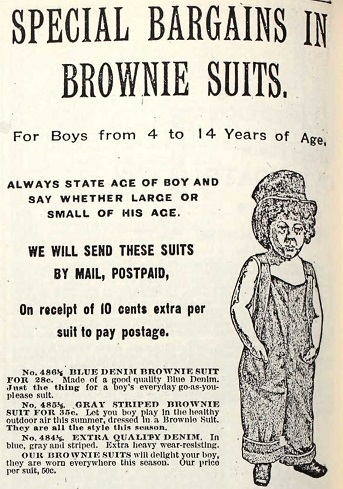
Sears Roebuck sold overalls for children “4 to 14” as early as Spring of 1896. They called them “Brownie suits.” The model is not wearing a shirt: “Let your boy play in the healthy outdoor air this summer, dressed in a Brownie Suit. They are all the style this season.”
In 1907 the style had changed slightly.
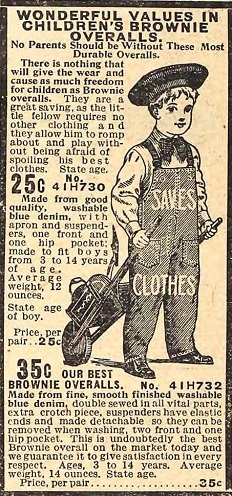
From a Sears catalog, 1907. Overalls were made of durable fabrics and allowed a boy to “play without being afraid of spoiling his best clothes.”
The pockets seem a bit small to me, but a boy wearing these could answer the call of nature without adult assistance, since the bib suspenders unhooked from the front.
In 1907, the boy who didn’t wear overalls might wear something like this:
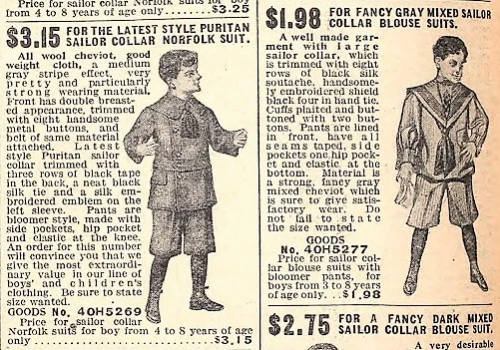
Clothes for boys from Sears catalog, 1907. Not really suitable for playing in the dirt.
Since overalls were made of heavy fabrics, and available at low prices from catalogs, I was a little surprised to see Butterick sewing patterns for them:
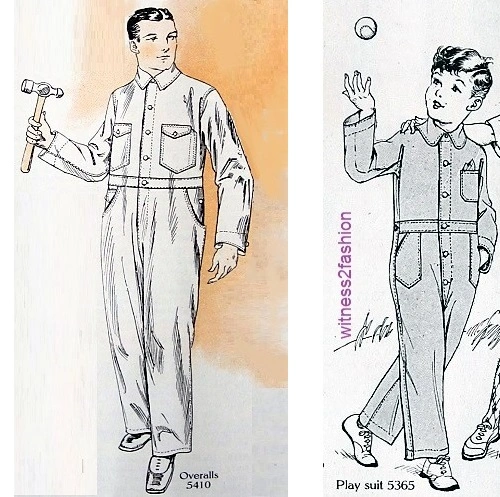
Butterick pattern 5410, for men’s overalls/coveralls, and Butterick 5365, a very similar “play suit” for young boys. Both from Delineator, 1924. Note: the word “jumpsuit” dates to World War II and is American in origin; in England they were called siren suits.
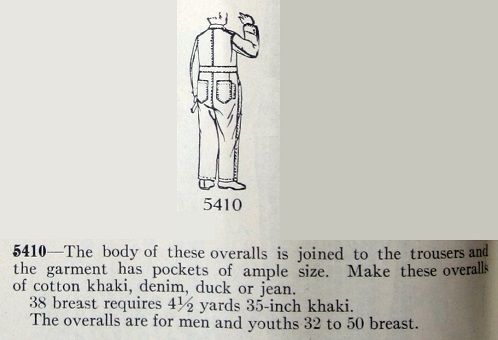
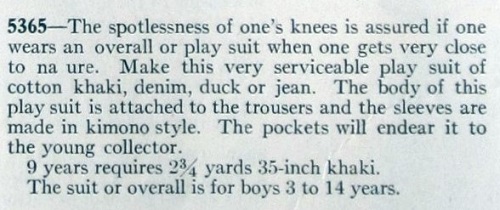
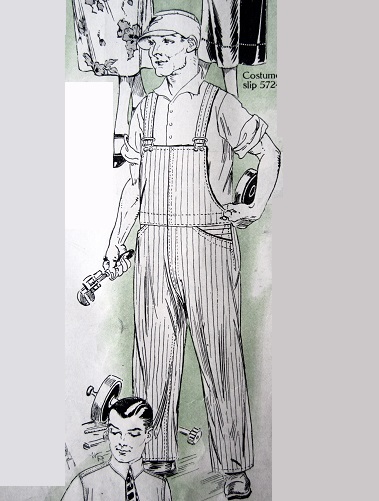
Butterick pattern 5780 for men’s bib overalls [also called apron overalls,] Delineator, January 1925. This man is a mechanic carrying a pipe wrench. My Uncle Mel, a plumber, still wore striped overalls in the 1940s and 1950s.

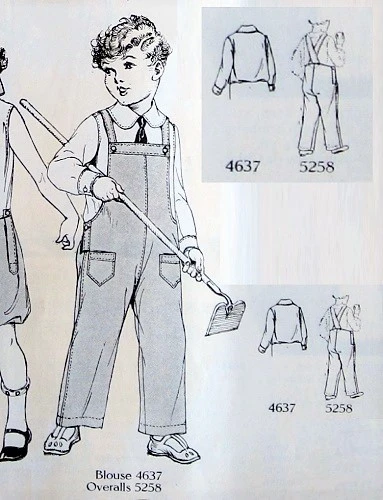
Overalls for boys two to twelve; Butterick 5258 from June 1924. He may be gardening, but professional farmers wore overalls, too. [And, more than 20 years later, my Grandma bought me sandals exactly like those he is wearing. Mine were always red, bought new at the start of each summer.]

Some children wore overalls as a matter of course:
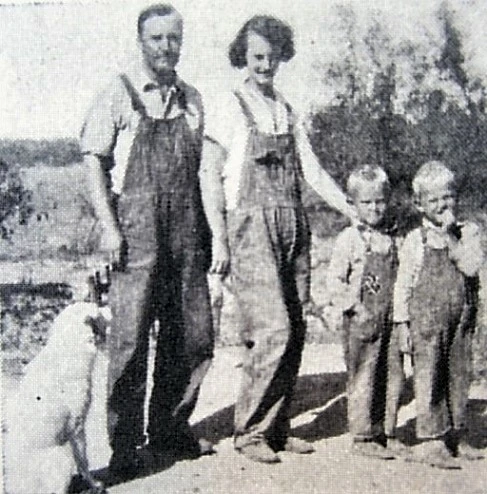
A farm family in 1934; photo from a Nujol ad in Delineator, April 1934.
For a well-illustrated article on bib overalls, as worn by farmers and others, click here.
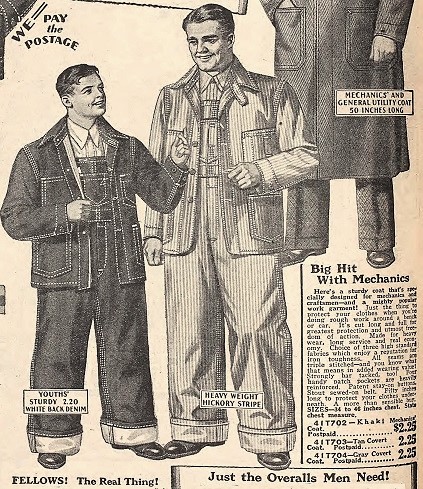
Overalls for a “youth” and a grown man, from Sears, Spring 1929. “Fellows! The real thing! … just like Dad’s!” Left, bib overalls and a matching jacket in “Sturdy 2.20 white back denim.”
My uncle, the plumber, wore dark, denim, indigo blue overalls with narrow white stripes — and a matching jacket — in 1950. Unlike modern plumbers who wear jeans, he could crawl under a sink without exposing cleavage in back.
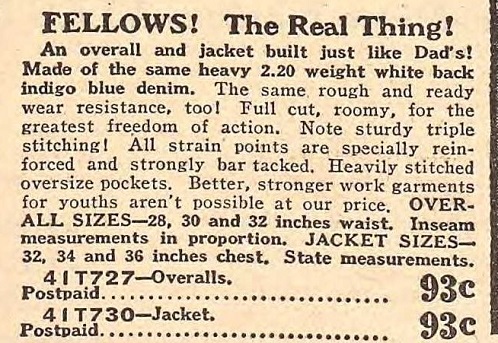
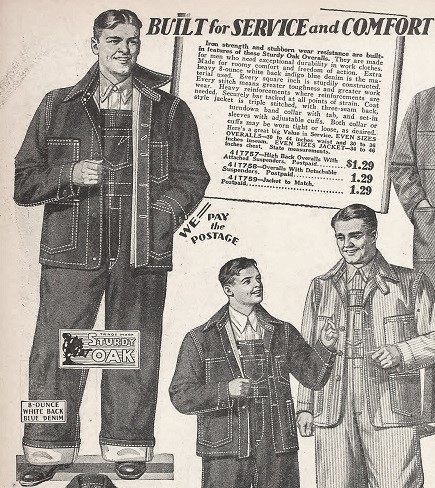
Sears overalls and matching jacket, Spring catalog, 1929.
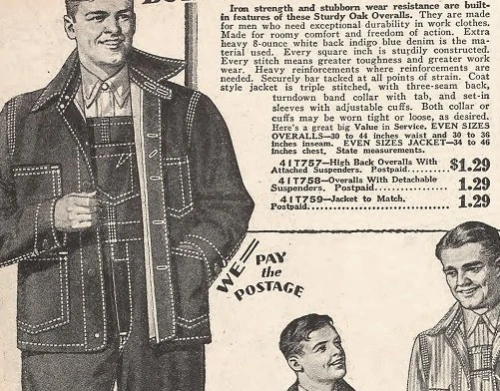
“Heavy reinforcements where reinforcements are needed. Securely bar tacked at all points of strain.” Levi Strauss used rivets to reinforce stress points — and held a patent.
One of the great things about bib front overalls was the specialized pockets.
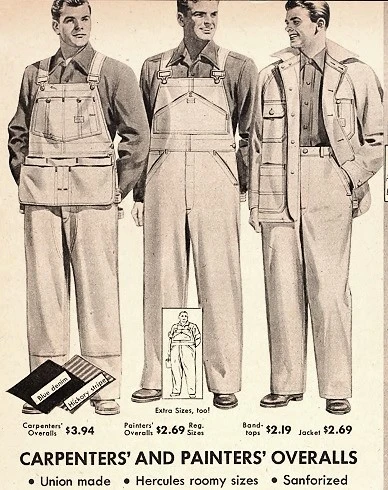
From the Sears Catalog, Spring, 1950. Carpenters overalls, left, have ample pockets for nails, a carpenter’s rule, carpenters’ pencils, and a loop on the side seam of the leg for carrying a hammer. Painters’ and paperhangers’ overalls have room for paint rags, etc. House painters traditionally wore white overalls.
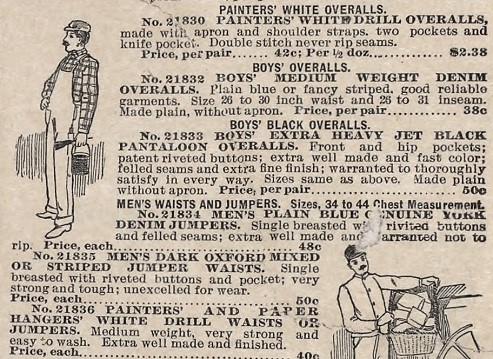
Sears overalls for painters and paperhangers, 1897. “Two pockets and knife pocket.”
If you’ve ever hung wallpaper, you’ll appreciate the knife pocket.
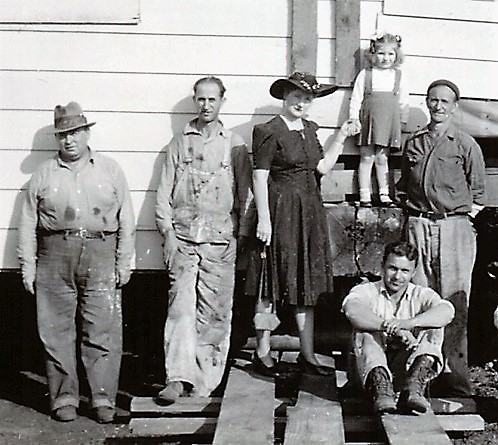
My father wears [once white] carpenter’s overalls in 1950. His foreman, at left, preferred dungarees and a blue work shirt. Note the foreman’s felt hat.
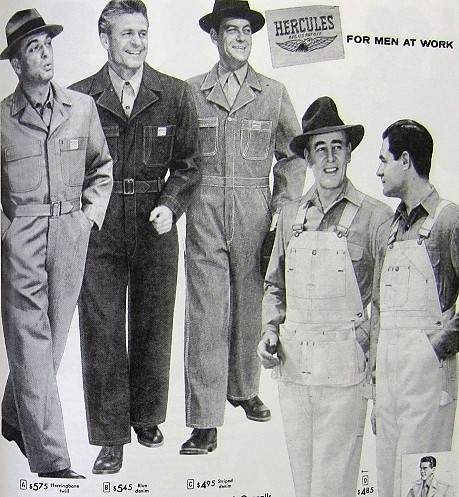
1956: Sears’ coveralls and overalls from Everyday Fashions of the Fifties. Coveralls were favored by auto mechanics; they had to lie on their backs to reach the undersides of cars. There’s not a baseball cap to be seen on these working class men from the 1950’s — they are wearing their old “good” felt hats.
In this illustration, a traveling salesman shows his wares to a woman he (understandably) mistakes for the farmer’s wife:
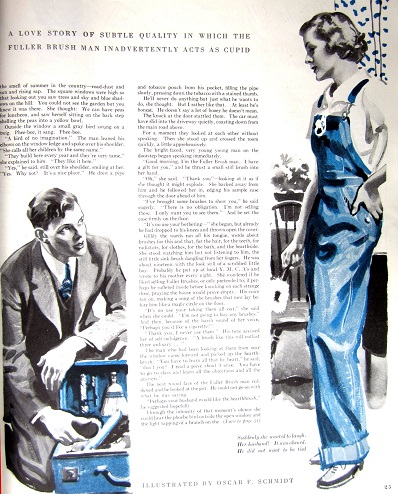
Story illustration, Delineator, February 1936.
However, overalls could be beach pajamas or play suits for women in the 1930s:
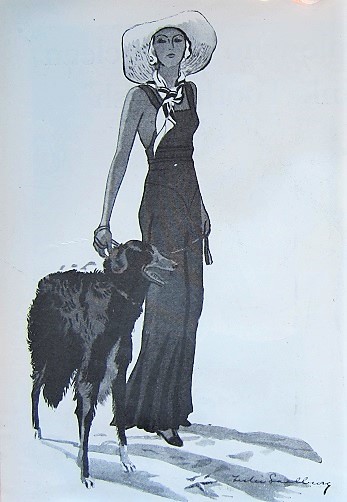
Masthead illustration by Leslie Saalburg for Delineator, March 1932. She’s not wearing a top under her overalls.
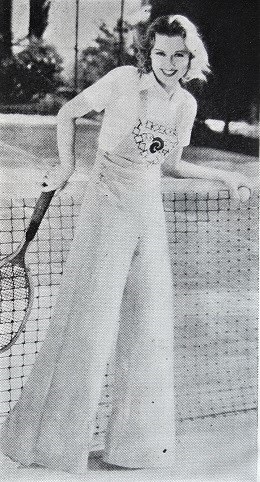
These pajamas were suggested for tennis in an ad from Delineator, June, 1932. They look like a trip hazard to me.
Women had worn men’s overalls when doing factory work in the First World War.
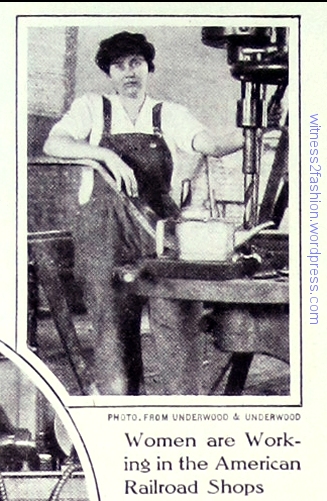
American woman, Ladies’ Home Journal, 1917.
They also wore them during World War II, but this 1940’s sewing pattern is for work or play:
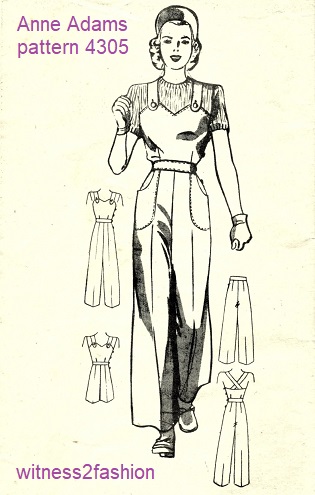
Anne Adams sewing pattern 4350 circa 1942.
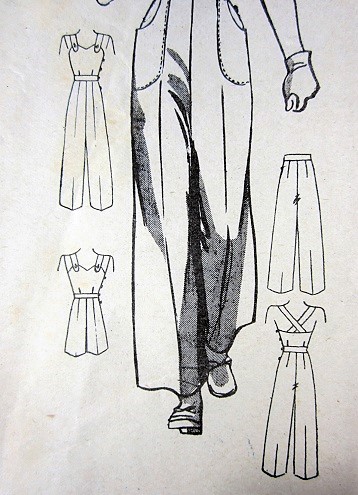
My father still wore overalls from time to time after he retired in the 1970’s. This striped pair have big, removable pockets attached with a zipper.
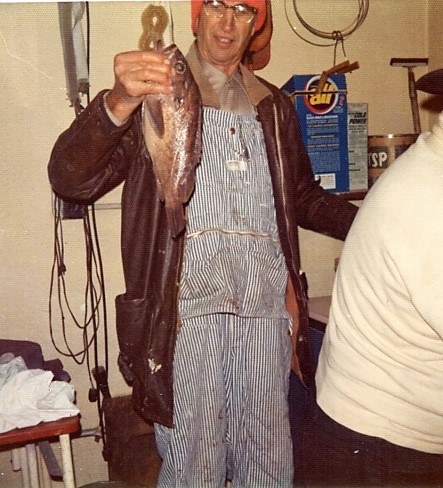
Striped overalls worn on a fishing trip, 1970s — better than gutting fish in your good trousers and shirt!
He’s standing in a basement laundry room. Automatic washing machines may explain why many workers now wear chinos or jeans instead of overalls.
Here are some overalls for children from the 1940’s:
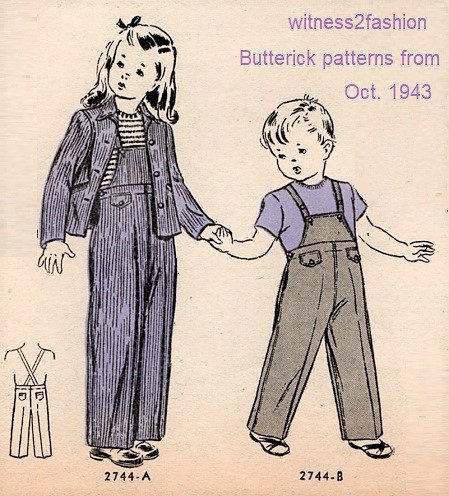
Overall-styled play suit (with matching jacket) from Butterick Fashion News, October 1943.
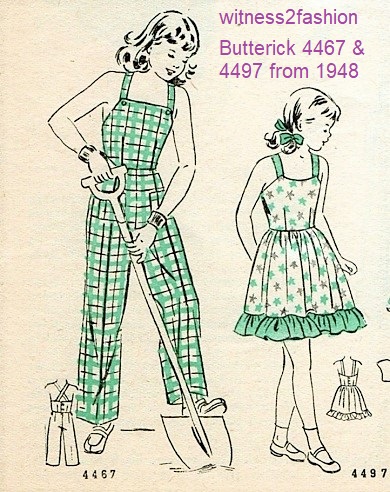
An overall/play suit very like the back-baring beach pajamas of 1932, with narrower legs. Butterick Fashion News, August, 1948.
Overalls for children continue to be popular. These brand new striped overalls from OshKosh are faded and aged before being sold.
I don’t remember these, but here’s proof that I used to wear overalls, too:

Witness2fashion in overalls, early 1950s. The curls and the hair bow were my mother’s idea.
What’s with the dirt piles? My father was a housemover; the house behind me is “up on blocks” and on its way to a new location.
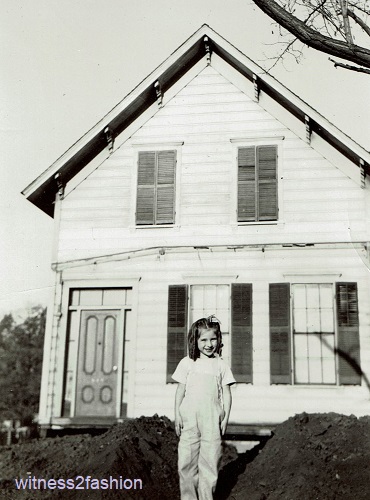
A house being moved from one location to another, California, 1950s.
In England, “housemovers” move furniture, but in my part of the world, where wooden houses survive earthquakes better than stone or brick ones, housemovers could separate a house from its foundation and move it to a new location, often miles away, while keeping it perfectly intact. It was definitely skilled work.
P.S. The Vintage Traveler supplied a link to the article in Paris Review: The Jumpsuit That Will Replace All Clothes Forever. We’re not convinced.
